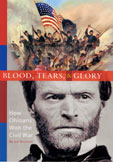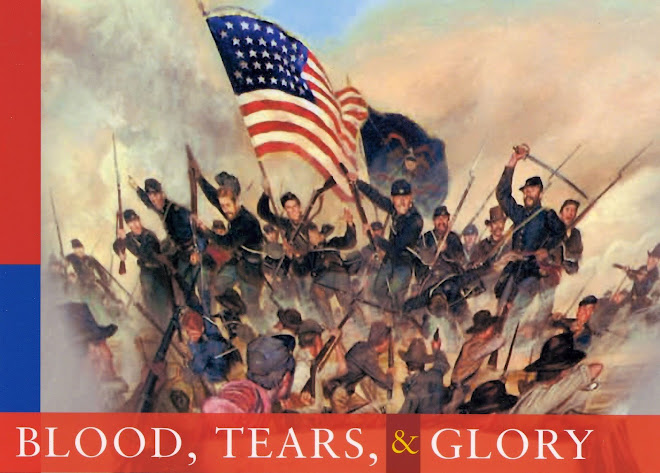
It falls to me to write you the sad news…
There were many ways to die in the Civil War, and combat was only one of them. Of the more than 600,000 Americans from both sides who lost their lives in the war, about two-thirds died from something other than wounds. The toll on the nation was horrendous: from one state alone—Ohio—35,000 men died while in the service, about one of every 10 men who served (and about 1.5% of the state’s 1860 population). The war tore out whole strips of population from some towns and villages. (Pictured: "The Empty Chair," a sentimental depiction of death.)
Medical care was, in a word, horrendous, “more medieval than modern,” someone observed. Germ theory was unknown and surgical techniques primitive, meaning amputation was all too often the remedy of choice for wounds to limbs. The army medical corps was poorly equipped and organized, soldiers lived in filth, and boys raised on isolated farms had no natural defenses against the diseases carried to camp by city dwellers.
A Union volunteer nurse observing the siege of Petersburg in June 1864 saw the dead and dying carried into tents "to be rolled together like the logs on a corduroy road….Worms soon bred in fresh wounds." She said the wounded were sometimes left on the field until “the sun burned their faces till the skin pealed away, and in the agony of thirsts and fever it seemed like a merciful relief when their spirits rid themselves of the mortal and mutilated bodies.”
The year before, a Gettysburg resident trying to sleep during a night-time interval between battles listened to the soft pleas of wounded Confederate, stranded in a no-go zone, for “Wahter! Wahter!” Retreating from Gettysburg, Lee’s wounded men cried out, “Oh God, why can’t I die?” and “Will no one have mercy and kill me?” as they endured teeth-rattling ride in ambulances lacking springs and cushions.
Nor was there any well-organized system for notifying survivors of the loss of their loved ones. Company captains or other officers would write families when and if they could, but their letters were subject to the vagaries of the war-time mail system, and it could take weeks for the news to reach its destination.
After the battle of Chickamauga in September 1863, it was two weeks before a surviving member of the badly cut-up 21st Ohio could notify his relatives of the death of their son, his cousin and a member of the same company. To the boy’s father, the soldier began a short letter this way: “It falls to me to write you the sad news of the death of your son. He died nobly while defending the old flag. He was shot in the breast and died almost instantly.” The rest of the short letter was a description of the battle. Other letters went to the boy’s mother (“a good soldier, I tell you we miss him”) and his siblings (“he was beloved by all the company and all who knew him”).
And that, for the time being, had to do for the bereaved. If they were lucky, the family might retrieve the body, then or much later (in this case, they could not) and they might get his personal effects. In this case, all the soldier left behind was an overcoat, which the company lieutenant sold, promising to send the money to the family.
Of Ohio’s 35,745 war dead, about 61% died from disease (of which, about 11% were prisoners of war) and about 33% died from battle injuries. (About half of those dying from disease died from intestinal disorders, primarily typhoid, from noxious water.) Of the remaining Ohio fatalities, 784 men drowned, 384 died in other accidents 34 committed suicide, 24 died from sunstroke, 23 were murdered, 6 were punished by execution by Federal military authorities, and 22 were deemed to have been “killed after capture” or executed by the enemy. About 5% of Ohio’s war dead died from a hodgepodge of other causes, or from causes unknown.
ELSEWHERE IN THE WAR: In southeastern Kentucky, on this day, January 20, 1862, Union troops under Brig. Gen. George H. Thomas pursue Confederates fleeing from the battle yesterday at Logan’s Cross Roads (also known as the battle of Mill Springs). By abandoning most of their supplies (and the dead body of their general) on the north side of the Cumberland River, the frazzled Confederates finally achieve safety on the south side of the river.
Meanwhile, from the peace of winter quarters in western Kentucky, Cpl. Alfred Searle writes his father in Bellevue, Ohio, a letter mostly about the bad weather and the declining health of his regiment. A man in Searle’s company has died of “inflammation of the brain” and with little sympathy: “He was a very wicked man.” A man in another company handled his rifle carelessly and accidently shot himself, dying instantly. The weather and the deaths have put Corporal Searle in a funk: “I do sometimes think of home, but have but little hope of ever seeing it again….Farewell. Perhaps this may be the last that you will ever have from me.”
In winter's gloom and cold, the mood is not good, north or south, at home or in the camps.IT’S COMING SOONER THAN YOU THINK:
Your suggestions, comments, and questions about this blog are always welcome. Address the author: Ohioan@bloodtearsandglory.com
For more information about the author and his newest book, please go to http://www.orangefrazer.com/btg



No comments:
Post a Comment